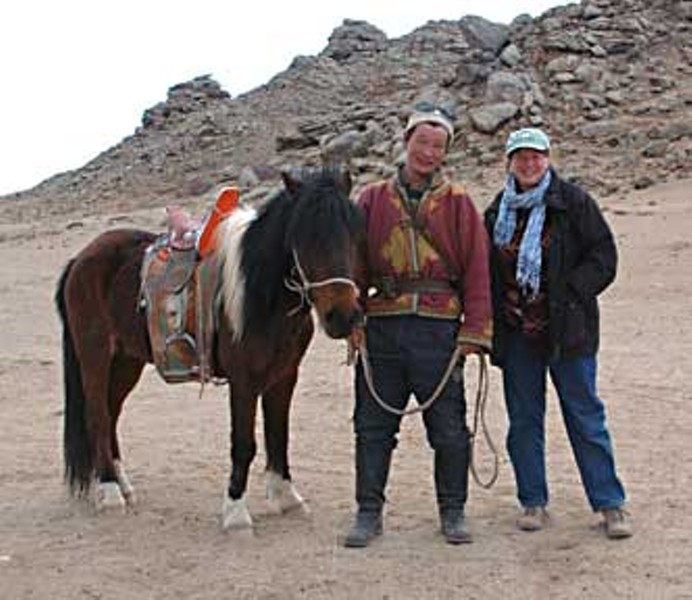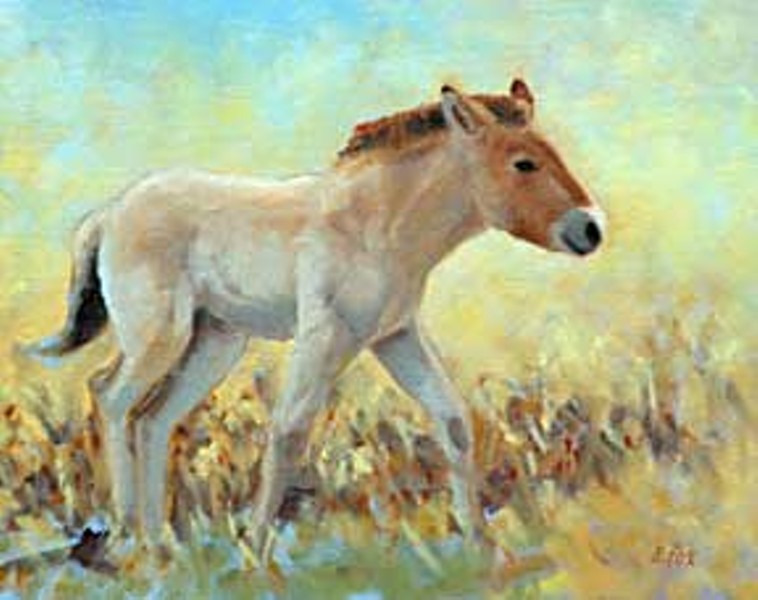The cave paintings of Lascaux are some of the oldest known artworks, dating from between 13,000 to 25,000 BC. Among the paintings are depictions of horses with short, thick heads and stocky bodies. The similarity between these horse paintings and the takhi horses, the last wild horse species in the world, is striking. That's something to think about when you're looking at Susan Fox's representations of the wild takhi.
Susan is a local wildlife artist with a deep passion for animals. Not only do various species stroll casually about her home and studio (several cats and an enormous collie by my reckoning; there may be more), but she also actively seeks them out in the wild, in order to paint them. "I don't paint what I haven't seen, preferably in its home habitat," she says.
While her love of animals is universal, she's especially taken with horses, and has been interested in a particular type of wild horse all her life. Her knowledge of the species was very general until she saw some of the takhi horses in Berlin's Tiergarten in 2004. This was the first event that spurred her on to an adventure in Mongolia, the only place in the world where these animals run free.
Then she saw an ad for an Earthwatch Institute expedition going to Mongolia. Traveling alone to exotic places is not always easy, and here was an opportunity to go with a group who would take care of all of the arrangements. (For more about Earthwatch Institute expeditions, visit their website at earthwatch.org.) While the planned trip did not include a visit with the horses, Susan arranged a side journey to Hustai National Park, where the animals had recently been reintroduced to the wild. Thus began her quest to seek out the takhi in its natural habitat.
Susan sees great importance in viewing animals up close and personal in order to paint them. "There's no point in doing this if I'm not going to try to be as good as I can possibly be," she explained. She follows the example of the finest landscape and wildlife painters who, as she says, "don't just settle, they make it their business to get the reference they need and if they don't have it, they don't paint it."
A painting won't grab people and move them unless the viewer recognizes something of the human experience in it. Therein lies the importance of being there. Susan thrived on the quality of the Mongolian wilderness and the silence she found there that is so elusive in our part of the world, where, she said, "the loudest sound was the blood circulating in my head."
The first time she saw the takhi running free was a revelation, and her memories of the locale are critical to the paintings. "You bring your presence in the place to the painting. You bring what you are and how you see things," she said.
Then there are the subtle details of the animals themselves. Why not just settle for seeing them in zoos? "It's the vibe that an animal in the wild has," Fox explained. There's that basic tenet of wildlife - he who is not paying attention becomes dinner. "These animals are paying attention," Fox says. They don't have the slightly dazed look of an animal that has all of its needs met and nothing after it. Alert and aware, the consciousness of the horses comes alive in the paintings.
One reason for focusing on the takhi in particular is the fact that they have only recently enjoyed this freedom. They had been extinct in the wild since 1969. The number of these horses in captivity was down to 54 before World War II. Since then, scientists have been carefully breeding them to bring their numbers up, carefully reducing inbreeding problems and getting them ready for release into the wild, which first happened in Mongolia in 1992.
Fox paints animals in their natural habitat out of her passion for and interest in them, but, as she explained, she cannot separate her love of painting animals from wanting to ensure there are animals to paint. "And in order to ensure that, there has to be a place for them."
Her painting can go full circle, then, because as she expresses her love of these rare animals, the paintings raise awareness about the issues of habitat protection, and people on the other side of the world start to care about animals they might never have an opportunity to see otherwise.
Horses are an easy thing for humans to love. We've had a relationship with them for aeons, and wild horses especially stir in us our own love of freedom. Stretching powerful legs, reaching out long necks, running for the pure joy of running, manes flying in the wind - come on, doesn't that just get your blood pumping? For this area of Mongolia, through Fox's paintings, the takhi are the "charismatic megafauna," those animals that people easily fall in love with and so become the driving forces in conservation efforts. By getting the takhi back to their natural environment and maintaining it for them, all of the other species in that part of the world benefit.
The body of work that Fox has produced since making her trip is still relatively small, but you can see what she has done so far and hear her talk about her adventures in Mongolia by signing up for her lecture at HSU's Natural History Museum on Thursday, March 22. It's at 7 p.m. and it's only 2 bucks if you're a member (double that if you're not). The museum is located at 1315 G St, in Arcata. You can register in advance online at www.humboldt.edu/~natmus. Visit Susan Fox's website www.foxstudio.biz to find out more about her artwork.



Comments